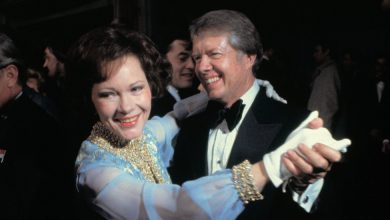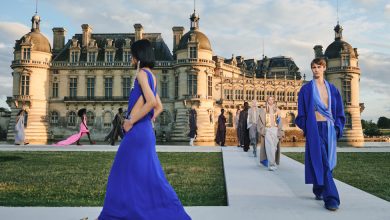Kerby Jean-Raymond’s Really Big Idea

In the summer of 2020, when the United States was being roiled by the aftermath of the George Floyd murder and businesses of all kinds were coming face to face with their own systemic racism, Kerby Jean-Raymond, the founder and designer of Pyer Moss, who has used his brand to shed light on Black history as well as police brutality, began to get a lot of calls.
“Everyone was saying we need to do something, we need to start something — Black this, Black that,” Mr. Jean-Raymond said.
“I was like, ‘Actually, I already did.’”
Months earlier he and Kering, the French luxury group, had quietly begun working on a project called Your Friends in New York, conceived to support emerging designers of color and rebalance their lack of representation in fashion.
But it was a long-term idea and shrouded in mystery; no one knew exactly what it was, and the founders weren’t talking, aside from a brief news release announcing its inception. Here’s what it did not involve: posting black squares on Instagram.
Here’s what it did: creating a company that would act as an incubator to shape nascent, outside-the-establishment businesses into profitable ventures, the better to create what Mr. Jean-Raymond, 35 and the majority shareholder, called “an ecosystem where I feel safe and comfortable to win and lose.”

Kerby Jean-Raymond of Pyer Moss and Your Friends in New York: “I have very clear intentions of what I want to do, who I want to be, who I want to help. And what i want my legacy to be in this industry. If nothing else, I want to be able to say not only did I create something beautiful in Pyer Moss, I also helped other people see their dreams through.”Credit…Rog and Bee Walker, PAPER MONDAY for The New York Times
“With Black people, there can only be one of us,” he said. “And when there’s two of us or three of us, they pit us against each other. That’s a real thing. Now, every Black designer who comes out with a bag is compared to Telfar.”
He wanted to change the pattern. And if fashion wasn’t set up to create that world, he was going to build it for himself.
For the last year, a group of eight designers chosen by Mr. Jean-Raymond has been working under the banner of YFINY, moving in and out of space in an old warehouse in Industry City on the Brooklyn waterfront.
They include Edvin Thompson of Theophilio, who was just named emerging designer of the year at the Council of Fashion Designers of America awards; Anifa Mvuemba, who in mid-November had her first live Hanifa show at the National Portrait Gallery in Washington; Taofeek Abijako, the founder of Head of State, which had its first presentation on the main New York Fashion Week calendar in September; and Raul Lopez of Luar, whose recent handbag release sold out in two hours, according to the designer.
All of it made possible by YFINY.
YFINY helped with financing, production and planning (and emotional support), but it owns no equity in the brands and doesn’t make any money from them. In turn, the brands share information, best practices and their own learning experiences with one another, as well as with Pyer Moss, Mr. Jean-Raymond’s brand, which is also now part of YFINY.
In other words, it looks kind of like a cross between a tech accelerator, a support group and a fashion cooperative.
“I think this is truly a next-gen idea,” said Krishna Nikhil, the chief merchandising and marketing officer of Ssense, an e-commerce platform that was an early sponsor of YFINY. The point being, “We’re not competing against each other. We’re all in it together.” And we can all make money together.
‘What Is This Guy Doing?’
In 2018, Mr. Jean-Raymond was a finalist for the CFDA/Vogue Fashion Fund, along with nine other designers, including Mr. Lopez. Mr. Jean-Raymond won. After he made his acceptance speech, Mr. Lopez said, Mr. Jean-Raymond jumped offstage and came straight to him.
“I’m like: ‘What is this guy doing? I just lost,’” Mr. Lopez, 33, said. “He grabs me, says in my ear, ‘I got you, give me a few, I’ll come back.’”
Mr. Lopez thought, “What does that mean?”
One of the biggest problems in fashion is not talent or ideas but building a business. Students at schools like Central Saint Martins are celebrated for their creativity but not taught how to work with supply chains or spreadsheets or tax codes or the terrible economics of the industry.
It is not a myth to say that many designers start their companies from their personal bank accounts and credit cards and get impossibly overextended as they are blinded by the allure of fashion shows and potential investors.
“I had my first show in 2013,” Mr. Jean-Raymond said. “It was only eight years ago, and a lot of those designers are gone now.” Names like Public School, Wes Gordon (who closed his own brand and is now at Carolina Herrera) and Sies Marjan. Indeed, Mr. Jean-Raymond almost lost his brand in 2017 after falling out with investors; he said he had to sell most of his furniture to keep going.
These issues are only more complicated for designers of color. For many of them, said Kethlyn White, the senior director of YFINY (though she is officially a Pyer Moss employee), “there was never enough access in the first place.”
So when Mr. Jean-Raymond got a call in late 2019 to meet with François-Henri Pinault, the chief executive of Kering, he didn’t have visions of a creative directorship at a Kering brand like Bottega Veneta or Saint Laurent; instead he began talking about a vision of another kind. What if they could create a support structure for young designers that would marry an established sponsorship model with an increasing affinity for community and entertainment?
This was, after all, not long after the Pyer Moss news-making Sister Rosetta Tharpe show at Kings Theater in Brooklyn, in front of an audience of approximately 3,000, many of whom swarmed a merch table at the after-party as if it had been a concert. Pyer Moss made “six figures in 20 minutes,” according to Mr. Jean-Raymond.
Mr. Pinault said yes immediately. Later Ssense signed on and committed to an annual buy from YFINY, data sharing and promotion on their various platforms. Beats by Dr. Dre agreed to provide grants and technology as needed: iPads, headphones, speakers. Instagram, Ms. White said, offered funding, data and help with direct-to-consumer shopping infrastructure. Each company also offered mentorship help and agreed to an initial two-year period.
Then Mr. Jean-Raymond began to talk to designers.
‘What’s the Catch?’
Taofeek Abijako, 23, started his street wear brand Head of State from his bedroom in Albany when he was still in high school. He was looking for a way to fund a water system in the village in Nigeria where his parents were born, and fashion seemed a good option. By early 2020, though, he was contemplating selling 20 percent of his business to an investor in a deal that would have given the investor control over his production. Then Mr. Jean-Raymond called to tell him about YFINY.
“At first, part of me was like: ‘What’s the catch? Would there be an equity request?’” Mr. Abijako said. “He said, ‘Nothing!’”
That’s not entirely true. Though the designers sign on with effectively a handshake agreement as opposed to a contract, there are “usage agreements” for the grants they receive, to ensure they will use the money they are given according to the strategy devised for them by YFINY. Mr. Jean-Raymond may not get any money yet from YFINY (though it’s not a charity, and the company will reap the fruits of future merch sales), but he gets a support system and is spared from feeling “guilty” about being the guy who won.
“It’s not fun alone,” he said of fashion. “I need people to compete with. I’m trying to build a community so I can find reasons to keep loving it and keep doing it.”
For its part, Kering gets first look at a new crop of talent without the whiff of feudalism attached to a prize, as well as a bird’s-eye view on new ways of selling and communicating without any risk to its more boldface brands. Ssense gets first dibs on the new collections its audience craves.
It’s just that the rewards are more reputational and abstract than quantifiable. That may not have been an attractive idea even five years ago, but as notions of inclusivity and equity have become ever more valuable in big business, it has taken on a worth of its own.
Laurent Claquin, the head of Kering Americas, called it “an investment in relationships.” He said that Kering put up a seven-figure amount (he declined to specify the exact figure), but he also said it wasn’t a material factor in Kering’s profit and loss statements. Neither YFINY nor the brands are considered part of the group.
Some of those brands were well on their way to making money, and others had essentially no income. But they all, Mr. Jean-Raymond said, had an identifiable “community.”
Take Everard Best, the co-designer, along with Tela D’Amore, of Who Decides War, another YFINY name. “He lives in Flatbush, he’s into anime, he’s into God, he’s into these cut-up, upcycled pants and all this crazy stuff, and I could never dress like that,” Mr. Jean-Raymond said. “But when you go to his shows, everyone looks just like him.”
Or take Ms. Mvuemba, and her decision to show in Washington, not New York. “Most middle-class affluent Black people come from the DMV area on the East Coast, and they are in no way, shape or form being talked to or being catered to by any American brands,” Mr. Jean-Raymond said. “She’s saying, ‘I’m going down there, and I’m going to be their Miuccia.’”
Originally YFINY planned to have an annual “festival,” like the Kings Theater show only much bigger, maybe over a few days, with fashion and music and wellness and tickets and merch for sale. Desiree Perez, the chief executive of Roc Nation, is on the YFINY board, and though the pandemic put those plans on hold, the company is hoping it may happen in the future.
In the meantime, YFINY has focused on infrastructure for the brands, including trademark protection, accounting and even therapy.
“Usually during this time of building, designers lose themselves,” Ms. White said. “They’re not eating, not sleeping, they’re exhausted. We want to make sure they’re taking care of themselves.”
Mr. Jean-Raymond has numbers in mind. “If I can get all these brands to 30K a month in direct-to-consumer revenue, and then 60K and then 100K, then they are $1 million businesses, and that’s proof of concept and self-sustaining,” he said.
Proof of Concept
Mr. Thompson, 29, who grew up in Jamaica and landed in New York by way of Atlanta, said YFINY had come at a pivotal time in his career. He had just quit the Red Lobster job that had been his security blanket for nine years to concentrate fully on Theophilio. It was “nerve wracking,” he said. He was considering taking a collaboration with Urban Outfitters to have a more reliable income stream when YFINY stepped in.
“It was really nice to have a sense of agency to say no,” he said.
When he won the CFDA award, it was a victory for them all, he said. He had a big after-party. Mr. Abijako was there, as was Johnny Nelson, the jeweler and another YFINY participant, and Mr. Jean-Raymond. The next week, Mr. Thompson went to Washington and sat in the front row of the Hanifa show with Mr. Jean-Raymond, who had been at everyone’s show during fashion week.
“I always thought the coolest movements were when my favorite musicians introduced other musicians to be on their record labels,” Mr. Jean-Raymond said. “Jay-Z introduced Kanye, Rihanna, J. Cole to Roc Nation. Lil Wayne brings Drake and Nicki Minaj to Young Money, Drake brings DVSN. I think that is beautiful.”
Right now the plan is to nurture the class of 2022 — which also includes Nigella Miller of AFRA and Geron McKinley of GIM Brand — through another season, then see where they are. Some of the smaller brands (“emerging”) may graduate to the next level (“scaling”); some may graduate to what Ms. White calls an alumni network. She wants to add a few more names to the group.
Mr. Jean-Raymond is looking for a building to buy that can serve as a base, to house some shared sampling facilities and create a stream of pop-ups showcasing pieces from the brands as well as YFINY merchandise, so visitors will never quite know what they are going to see.
“Fashion has become such a big part of the American lexicon that the question of who can buy into a brand with ready-to-wear is going to be less important than who can support a brand,” Mr. Jean-Raymond said. “The way things are shifting, it’s going to be about audience, it’s going to be about entertainment. It’s not going to always look like product.”
Ms. White thinks New York is only the beginning; she wants to export the concept to other cities. She imagines Your Friends in Los Angeles, Your Friends in Hong Kong, Your Friends in London.
“Right now we’re doing it for the love of each other, but at some part it becomes very beneficial,” Mr. Jean-Raymond said. “We can get to success a lot faster together than apart.”





